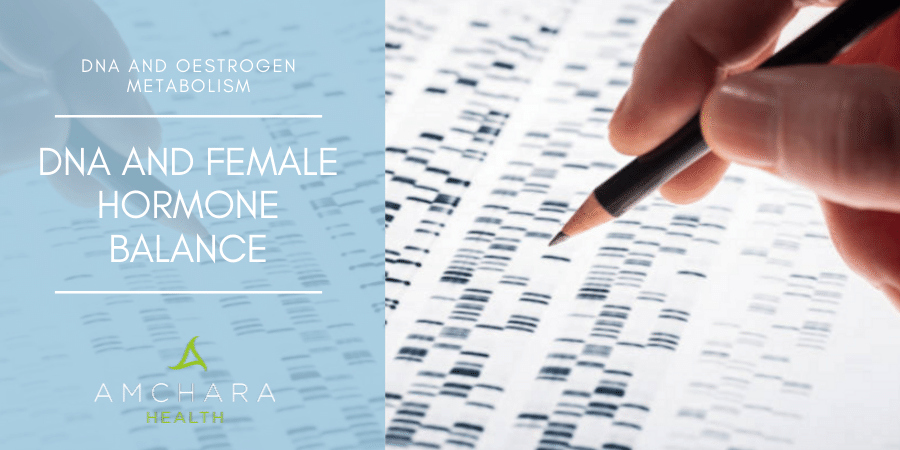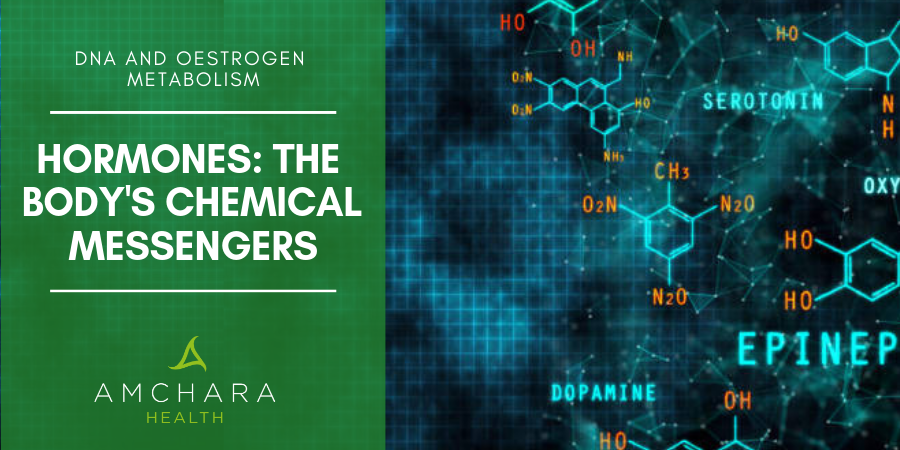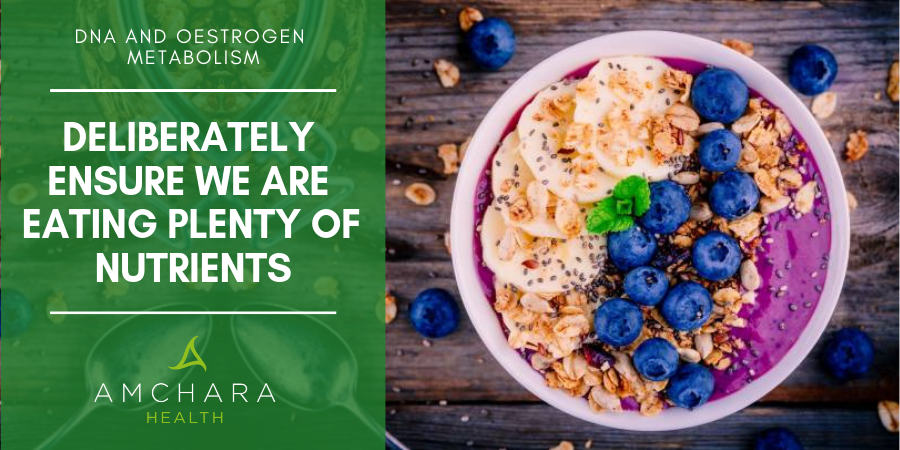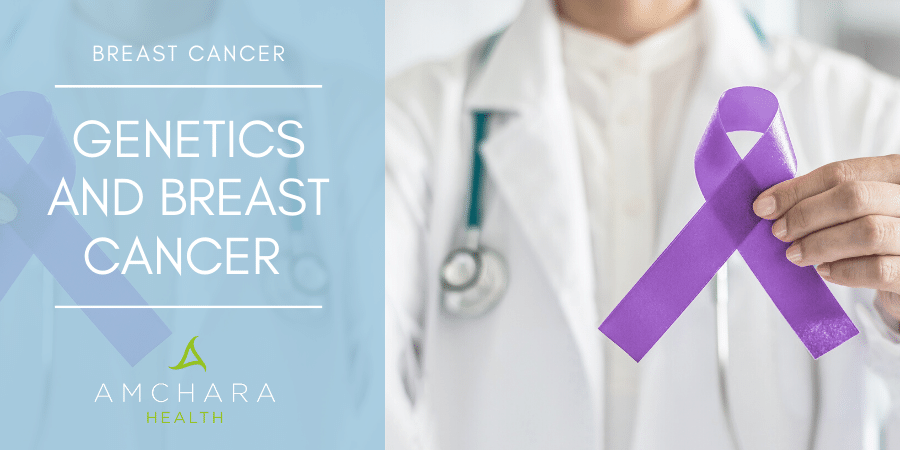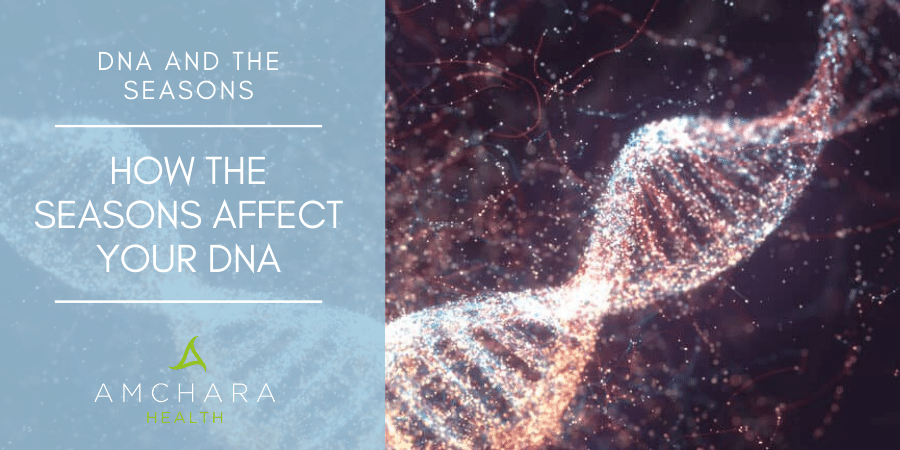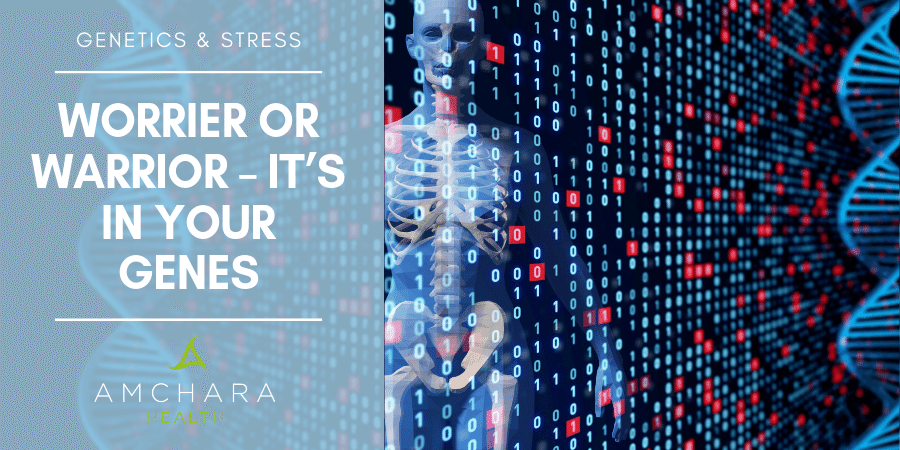Topics Covered in this article:
- What is DNA?
- Genes and enzymes
- It’s all in our genes – or is it?
- The science of epigenetics
- Types of epigenetic influences
- Epigenetics and our inheritance
- Epigenetics and hormone balance
- A brief word about female hormones
- Oestrogen dominance
- How do hormones work?
- Oestrogen metabolism
- Genetics and oestrogen metabolism
- How can I encourage healthy oestrogen metabolism?
- Epigenetic factors affecting phase I detoxification
- Epigenetic factors affecting phase II detoxification
What is DNA?
We all possess DNA in every single cell in our body. It’s our own personal instruction manual, containing the directions for how to operate as a living being.
Our DNA contains genes – over 20,000 of them. The function of a gene is to instruct cells how to behave.
Genes tell an ovary cell to function like an ovary cell or a pancreas cell to function like a pancreas cell.
Our genes tell our body how tall we are programmed to grow, our appearance, and can even influence how susceptible we are to develop illnesses such as cancer and diabetes
Genes and enzymes
Our genes have the job of instructing enzymes. Enzymes are special types of protein which speed up the rate of the chemical reactions taking place within every single cell of our body.
They’re important because they are involved in such a wide range of processes.
Think of genes as a film director, instructing actors – in this case the enzymes – when they’re needed on stage, when they need to deliver a specific line with extra emphasis, and when they can go off and have a cup of coffee.
It’s all in our genes – or is it?
For many years scientists believed we’re largely at the mercy of our genes.
It was thought we had almost no control over our risk of developing diseases.
In other words, it was believed we’re all at the mercy of our genes.
Exciting new research is discovering we have more control over our genetic influence than was previously thought.
Bring on epigenetics.
The science of epigenetics
Epigenetics is nature’s way of changing the way our cells behave.
‘Epi’ is derived from the Greek word meaning ‘outside of’ or ‘around’.
The DNA sequence we’re born with remains constant throughout our lifetime, but the way the genes are instructed to behave can change as a result of outside influences.
A change in genetic activity without a change in genetic code is known as gene expression.
This process allows our DNA to respond to the environment.
Compounds known as epigenetic markers sit on the gene strands and react to signals from the outside world.
They don’t alter our DNA but its effects are changed.
In the body, some genes are active and some inactive. Different types of epigenetic markers cause genes to be activated or suppressed – in other words, switched on or off.
This can happen at any stage of our life.
Genes can’t simply decide this for themselves – it happens in response to outside stimuli.
Types of epigenetic influences
The outside factors which can influence our genes include the food we eat, pollutants, how much we sleep, our stress levels, how much exercise we do and our age.
For example, environmental toxins can cause the wrong instructions to be given to genes and lead eventually to chronic disease.
One of the most commonly studied epigenetic markers is nutrition.
Certain chemicals in foods have been found to affect whether genes are turned on or off.
Epigenetics and our inheritance
Science is now finding epigenetic changes can be transmitted from generation to generation by making their way into egg and sperm cells.
The development of the embryo is then affected.
This makes sense, as humans have developed and evolved over time. It follows our environment will have been critical in supporting our genetic evolution.
All this means that even if you are born with an increased genetic risk of a particular disease process, your lifestyle choices can influence whether that risk expresses itself as disease.
In theory, if you maintain a healthy lifestyle, this, in turn, will influence your gene expression.
If epigenetic markers created by environmental influences could be reversed, it follows predispositions for certain diseases could be reduced.
Many high-profile celebrities have shared their decisions relating to their genetic predispositions for certain diseases like breast cancer.
Everyone’s health journey and decisions will be unique to them, but knowing what we now know about the influence of epigenetics on chronic disease, it would seem worthwhile to pay attention to our personal epigenetic influences rather than simply accepting we’re at the mercy of an inherited disease predisposition.
Epigenetics and hormone balance
The metabolism of hormones involves many different chemical reactions, all controlled by various enzymes.
Therefore our hormone metabolism is affected by epigenetics.
A brief word about female hormones
The human body produces two types of female sex hormones, oestrogen and progesterone.
Both help to regulate our menstrual cycle, but in this article, we’re going to be concentrating largely on oestrogen.
In menstruating women, oestrogen controls the growth of the uterine lining in the first part of the menstrual cycle.
Effectively it helps to produce an environment which is suitable for the fertilisation and implantation of an embryo.
After the menopause oestrogen plays a role in bone health.
However, this is rather simplistic as oestrogen also plays a host of other roles, having effects on the skin, hair, muscles, mucus membranes and even the brain and mood.
Researchers are also starting to appreciate oestrogen’s role in inflammation.
Oestrogen dominance
Many women experience health problems arising from oestrogen levels which climb too high.
Many health conditions and diseases such as PMS, fibroids, endometriosis, heavy and irregular periods, depression and anxiety, bloating, weight gain, thyroid problems and even some cancers are associated with oestrogen dominance.
This occurs when oestrogen levels are too high relative to progesterone.
This situation frequently occurs in menstruating women, whereas a lack of oestrogen is more common after menopause, when oestrogen levels naturally decline.
However, because of oestrogen’s wide-ranging effects on so many different body functions, oestrogen dominance will have a profound effect on our health.
How do hormones work?
All hormones, oestrogen included, exert their effect by stimulating a specific receptor molecule sitting on the surface of a cell which binds to that particular hormone.
Once they have done their job, the hormone must be converted to an inactive substance and eliminated from the body.
Otherwise, it would constantly activate receptor cells over and over again. This is what we mean by the metabolism of hormones.
Oestrogen metabolism
Oestrogen is fat-soluble, meaning it is repelled by water and tends to stick to fat.
However, hormones such as oestrogen are eliminated by shunting them into the urine, or into the bile, both of which involve water.
So the liver must transform oestrogen into a water-soluble molecule, because as we know oil and water do not mix.
The process occurs in two stages.
- Phase I detoxification
The first stage is called Phase I detoxification. During this stage, the structure of oestrogen is altered to prepare for its removal from the body.
The problem is, the molecules thus created are reactive molecules which can damage cells by oxidation if they escape into the circulation.
So it’s important they are rapidly converted onwards to harmless products and excreted.
This initial process involves enzymes in a family called Cytochrome P450 (CYP450).
During the biotransformation process, a particular chemical group is added somewhere in the molecule.
The compounds which are formed behave differently depending on in which position the chemical group is added.
In other words, there are different pathways oestrogen can travel on its way to being excreted.
Each pathway results in a slightly different intermediate substance being produced, which all have different effects.
Which pathway is used depends on which specific enzyme is involved which in turn depends on, yes you’ve guessed it, our genes.
Let’s have a look at the three main intermediate oestrogens.
- 2-hydroxy-oestrogens
These are the most common type of intermediate oestrogen.
They are produced because of instructions from a specific gene which directs a specific enzyme.
They are weak and fairly stable oestrogens.
It’s thought 2-hydroxy-oestrogens may be protective against oestrogen-dependent cancers.
- 4-hydroxy-oestrogens
These are more reactive compounds, strongly oestrogenic with the potential to produce more free radicals.
They’re usually produced in small amounts.
- 16-alpha-hydroxy-oestrogens
These are strongly oestrogenic. Studies suggest the ratio between the amounts of 2 and 16 forms of hydroxy-oestrogens can influence our susceptibility to breast cancer (1).
Ideally, our body would produce more of the 2 form than the 16 form.
- Phase II detoxification
The second stage of oestrogen detoxification, or Phase II, involves a number of possible different chemical processes.
They all involve adding molecules to the intermediary compound so it can be eliminated from the body.
- Methylation
The main method by which the body deactivates used oestrogens in Phase II detoxification is through a process called methylation.
During methylation, tiny molecules called methyl groups are added to the intermediary oestrogens. Some people are genetically programmed to be poor at methylation.
In the case of oestrogen detoxification, an enzyme called COMT is necessary to transfer the methyl groups to where they’re needed.
The COMT enzyme is encoded by the COMT gene. A lack of this enzyme caused by genetic predispositions can slow down this phase of detoxification.
- Glucuronidation
Another process involved in the deactivation of oestrogen is glucuronidation.
This is the part of the process which ensures oestrogen is water soluble and ready for excretion.
The ability to perform glucuronidation is very variable from person to person and is influenced by differences within the genes encoding enzymes involved in the process.
Like methylation, some people don’t perform this process very well because of their genetic makeup.
Genetics and oestrogen metabolism
We’ve seen how genetic differences, which can change according to external influences, affect the function of the various detoxification enzymes.
Scientists have noted large individual differences in how we metabolise oestrogen. This can have a number of potential effects.
The first effect is the overall speed of Phase I detoxification.
If a person is genetically predisposed to have a reduced activity of Phase I enzymes, they won’t clear oestrogen as quickly and levels of the hormone may rise.
However, a genetic predisposition towards a faster Phase I clearance isn’t necessarily a good thing, because this often leads to those reactive intermediary products building up to dangerous levels if Phase II can’t keep pace.
These can damage body cells as well as DNA, causing mutations which may lead eventually to cancer.
They do this because they are unstable molecules, which possess an unpaired electron.
They buzz around our body looking for extra electrons in order to make them more stable.
The second effect is on which specific oestrogen metabolite is produced at the intermediate stage.
The third major influence is how quickly Phase II detoxification proceeds.
If this phase is slow, there’s more likelihood of the intermediate oestrogens building up.
How can I encourage healthy oestrogen metabolism?
Now we know genes which influence enzymatic activity can be switched on or off by environmental factors, the question is can we influence these genes in order to affect our oestrogen levels?
Although research is ongoing in this area, the answer appears to be yes.
We can find out what levels of the various oestrogen metabolites we have by looking at what is contained in our urine.
This can give us a clue as to which pathways our body prefers.
A more detailed picture can be gained by also looking at how our genetics are driving our detoxification enzymes.
Once we know our genetic predisposition, we can take active steps to reduce or prevent expression of gene mutations, or to limit their influence, by avoiding environmental triggers like a poor diet or a stressful lifestyle.
We can also ensure we are eating plenty of the nutrients we may need in extra amounts owing to these mutations.
Epigenetic factors affecting phase I detoxification
If we discover our genetics are predisposing us to be poor at Phase I detoxification, we can eat plenty of cruciferous vegetables, which are known to play a role in this phase of detoxification (2).
Conversely, if we know our Phase I is set to high speed, a substance called ellagic acid contained in berries may reduce an overactive Phase I pathway (3).
If we can encourage the activity of CYP1A1 enzymes, then we can boost the production of healthier 2-hydroxy oestrogens.
Dietary measures such as decreasing alcohol intake, increasing exercise and eating cruciferous vegetables, olive oil and flaxseeds can help favour the production of these less damaging oestrogen metabolites.
This is sensible for all of us but especially valuable if we know we have a tendency to produce less of this type of oestrogen.
If we have a tendency to produce excess 16-oestrogen metabolites, we need to ensure we’re consuming plenty of antioxidants.
These are substances which possess an extra electron so can neutralise free radicals – they effectively stop them in their tracks.
Eating foods rich in antioxidants, found in colourful plant-based foods, is crucial if our detoxification processes are out of kilter.
Epigenetic factors affecting phase II detoxification
As far as Phase II detoxification is concerned, if this stage of detoxification is sluggish, we may benefit from eating more cruciferous vegetables, which also contain substances which can boost Phase II enzymes (4).
Magnesium is thought to increase the activity of the COMT enzyme. On the other hand, this enzyme can be inhibited by sugar (5).
Obesity and smoking can slow down glucuronidation.
Certain nutrients are crucial for methylation to occur effectively.
These include folic acid and other B vitamins such as vitamin B12, B2 and B6, found in green vegetables and legumes.
If these nutrients are in short supply, methylation slows down. It’s as if something is getting caught in a giant mill wheel, making it turn more slowly.
If we know we’re genetically programmed to be poor at methylation, we should ensure we’re getting enough of these nutrients.
Takeaway
Emerging knowledge about the influence of epigenetics on hormone balance is ushering in a whole new era of personalised health.
Genetic testing can be hugely useful as once we know our predisposition we can influence this by epigenetics.
At Amchara we offer genetic tests» which can tell you about your unique oestrogen detoxification genetic tendencies.
These tests can provide an in-depth analysis of your genetic make-up and gene expression affecting hormone balance by providing information about the highly individual functioning of your own metabolic pathways.
Genetic testing can open up a whole new avenue of possibilities to modify your health through epigenetics.
A consultation with one of our trained naturopaths or nutritional therapists can help to guide you through this process to help you make nutritional choices and lifestyle changes for your unique body.
We’re dedicated to providing you with both insightful information and evidence-based content, all orientated towards the Personalised Health approach.
Did you find this article useful?
With your comments, we’d love to continue the conversation.
By Cathy Robinson BScDipNutMed
READ THIS NEXT:
